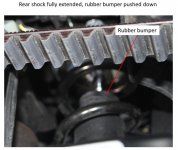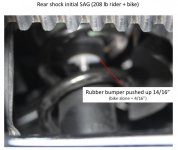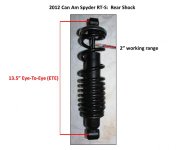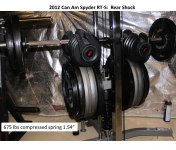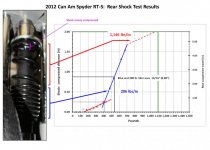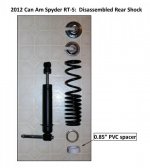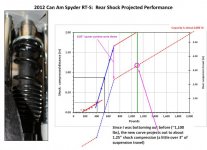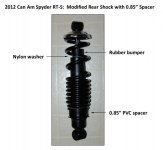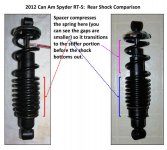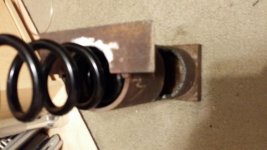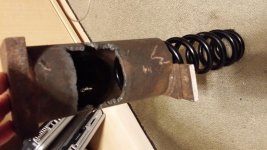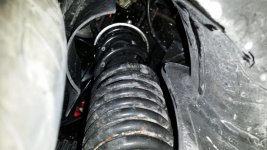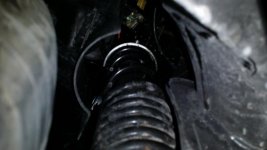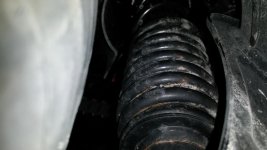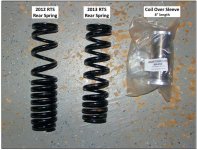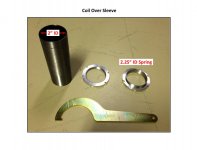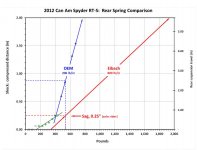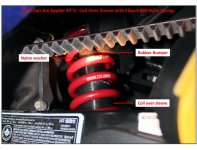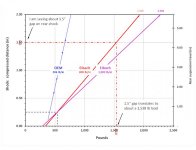spacetiger
New member
Time to start looking at the rear suspension. The work on the front suspension can be found here:
http://www.spyderlovers.com/forums/showthread.php?60792-2012-RT-S-SE5-Front-Suspension
It may take a while to get the time to take apart the rear of the bike to pull the rear shock, but I thought I'd start with the rear disc (nylon washer) to see how much of the rear working range I am using. It is my hope I can get the rear spring alone to meet all my solo riding needs and use the air bag to assist with a passenger load.
In looking at the rear spring, I can see it is a progressive rate spring. So it will have a lower transitioning to a higher spring rate. I will not be able to quantify those rates until I pull the shock and put it on the weight machine and compress it.
The working range looks to be about 2.5" like the front. With the disc (nylon washer) under the rubber bumper and both pushed all the way down (the rear wheel raised off the ground), I then lower the bike down, then back up. The disc is moved up 4/16". I then repeat the process except I sit on the bike while the rear wheel is on the ground. When I raise the rear of the bike, I can see the rubber bumper has been pushed up 14/16" (0.875") or 35% of the working range (0.875"/2.5"). So, even though I have not quantified the spring rates, I can see the spring is too soft by itself to adequately hold up the rear of the bike. I might get lucky and be able to add a spacer (like I did the front) to add additional preload to the spring so it is only using no more than 25% of the working range; we shall see.
While I wait for the time to take apart the rear, I will check the rear disc from time to time to see how much of the working range I use. I have a long ride coming, so it will be a chance to collect some good data.
Sorry the pics are not focused in the right spot, but you can see the necessary details.
Jerry
http://www.spyderlovers.com/forums/showthread.php?60792-2012-RT-S-SE5-Front-Suspension
It may take a while to get the time to take apart the rear of the bike to pull the rear shock, but I thought I'd start with the rear disc (nylon washer) to see how much of the rear working range I am using. It is my hope I can get the rear spring alone to meet all my solo riding needs and use the air bag to assist with a passenger load.
In looking at the rear spring, I can see it is a progressive rate spring. So it will have a lower transitioning to a higher spring rate. I will not be able to quantify those rates until I pull the shock and put it on the weight machine and compress it.
The working range looks to be about 2.5" like the front. With the disc (nylon washer) under the rubber bumper and both pushed all the way down (the rear wheel raised off the ground), I then lower the bike down, then back up. The disc is moved up 4/16". I then repeat the process except I sit on the bike while the rear wheel is on the ground. When I raise the rear of the bike, I can see the rubber bumper has been pushed up 14/16" (0.875") or 35% of the working range (0.875"/2.5"). So, even though I have not quantified the spring rates, I can see the spring is too soft by itself to adequately hold up the rear of the bike. I might get lucky and be able to add a spacer (like I did the front) to add additional preload to the spring so it is only using no more than 25% of the working range; we shall see.
While I wait for the time to take apart the rear, I will check the rear disc from time to time to see how much of the working range I use. I have a long ride coming, so it will be a chance to collect some good data.
Sorry the pics are not focused in the right spot, but you can see the necessary details.
Jerry
Attachments
Last edited:

